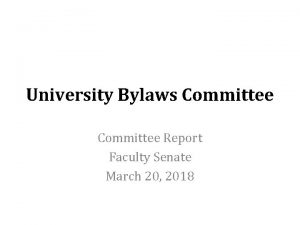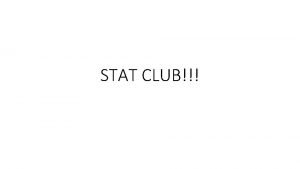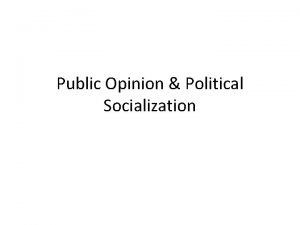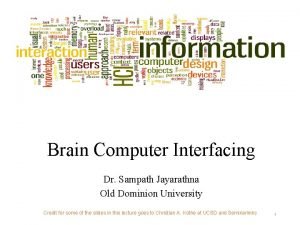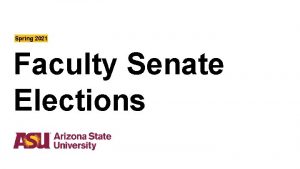Student Opinion of Teaching Effectiveness The Faculty Senate




- Slides: 4

Student Opinion of Teaching Effectiveness The Faculty Senate CET proposes that this evaluation process be conducted electronically online for the Spring 2011 and Fall 2011 semesters

A brief history • Committee for Effective Teaching (standing committee of Faculty Senate): – From 300. 030 Faculty Bylaws of the Missouri University of Science and Technology (1) This committee makes recommendations to the Faculty Senate, and the Provost, regarding the instruments used for student evaluation of teaching, the procedures for conducting these evaluations, and policies related to the public disclosure of the evaluation results. The scope of the committee’s responsibilities includes all aspects of teaching in courses with academic credit. (2) In addition to student evaluations, the committee may consider alternate methods of evaluating teaching, may suggest methods for improving teaching, and makes recommendations on the selection process and criteria for campus-wide teaching awards. (3) The committee consists of one faculty member, elected from, and by, each department desiring representation, one student selected by the Student Council, one graduate student selected by the Council of Graduate Students. Faculty representatives serve for three-year (3 -year) terms, and students serve for one (1) year. In addition, the Provost may appoint up to three (3) non-voting members to this committee. • COMMITTEE EFFECTIVE TEACHING AND FACULTY AWARDS – • The Committee on Effective Teaching and Faculty Awards is authorized and established by the Chancellor. It has responsibility for developing methods for the student evaluation of teaching, for assuring the integrity of the evaluations, for recommending methods for improving teaching and for nominating faculty members for special teaching awards established at Missouri S&T. The committee is expected to keep the faculty informed of its policies in consultation with the Faculty Senate. The committee's responsibilities include teaching in the formats of lecture, recitation and laboratory. The members of this committee are appointed annually by the Provost, who shall designate one member to serve as chairman. In September, 2008, the Faculty Senate created an Ad Hoc committee to review the teaching evaluation system: – Committee Purpose/Goal: The purpose/goal of the committee is to review the current student teaching evaluation system and recommend to the faculty senate improvements to the current teaching evaluation system as the committee may find appropriate. – This committee conducted trials of electronic teaching evaluations in Fall 2009 and Spring 2010

Results of Electronic Implementation of Student Opinion of Evaluation of Teaching Effectiveness Pilots I & II • Fall 2009 – 9 faculty and 12 undergraduate classes participated. Class sizes ranged from 21 to 190 – Response rate was 52% to 100%, with average of 69% (paper forms response rate has typically been 70 -74%) – In a follow-up survey: – Confidentiality of answers: 89% of students were as confident or more confident that their answers were kept confidential – Preference: • Students – 69% preferred electronic, 24% had no preference, 7% preferred paper • Faculty – 83% preferred electronic, 17% had no preference, and none preferred paper • Spring 2010 – 63 faculty and 167 undergraduate classes participated. Class sizes ranged from 2 to 143 – Response rate again averaged 70% – In a follow-up survey: • Overwhelming majority again preferred electronic evaluation to paper

Recommendation: • The CET committee has reviewed and discussed the results from the Ad Hoc committee, and concluded that electronic evaluation will: – Return results with a similar or better response rate than the previous paper evaluations – Result in significant saving to the campus in materials – Result in significant savings of time for those who administrate the process (VPAA and IT), the course instructors, and those who proctor the evaluations. – Be a green initiative in reducing our consumption of paper scan sheets and envelopes, as well as reducing the paper waste stream generated by confidentially shredding the paper scan sheets. – Return valuable class time back to the instructors of the courses • Thus, the CET committee proposes that: Electronic evaluations of teaching effectiveness will be implemented for all courses for the Spring 2011 and Fall 2011 semesters. Reports of the results will be presented to Faculty Senate after each semester, at which time the process will be re-evaluated for subsequent implementation.
